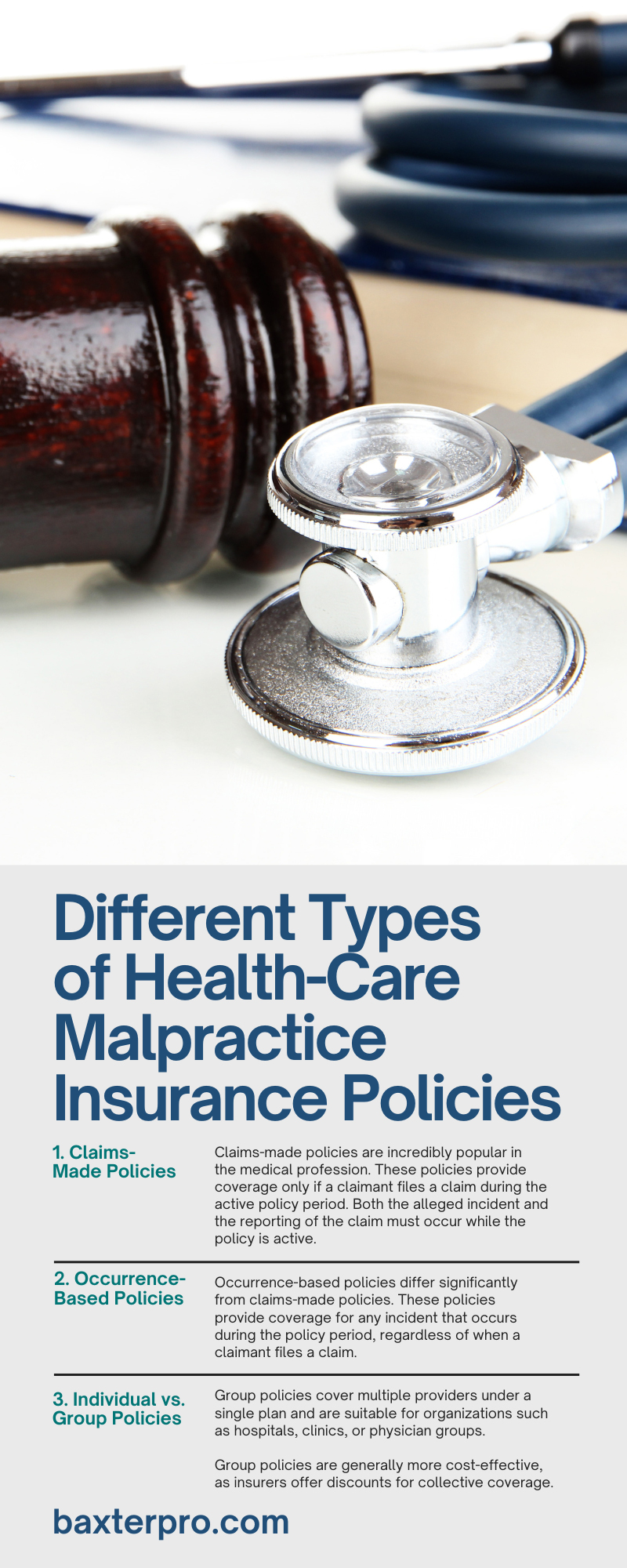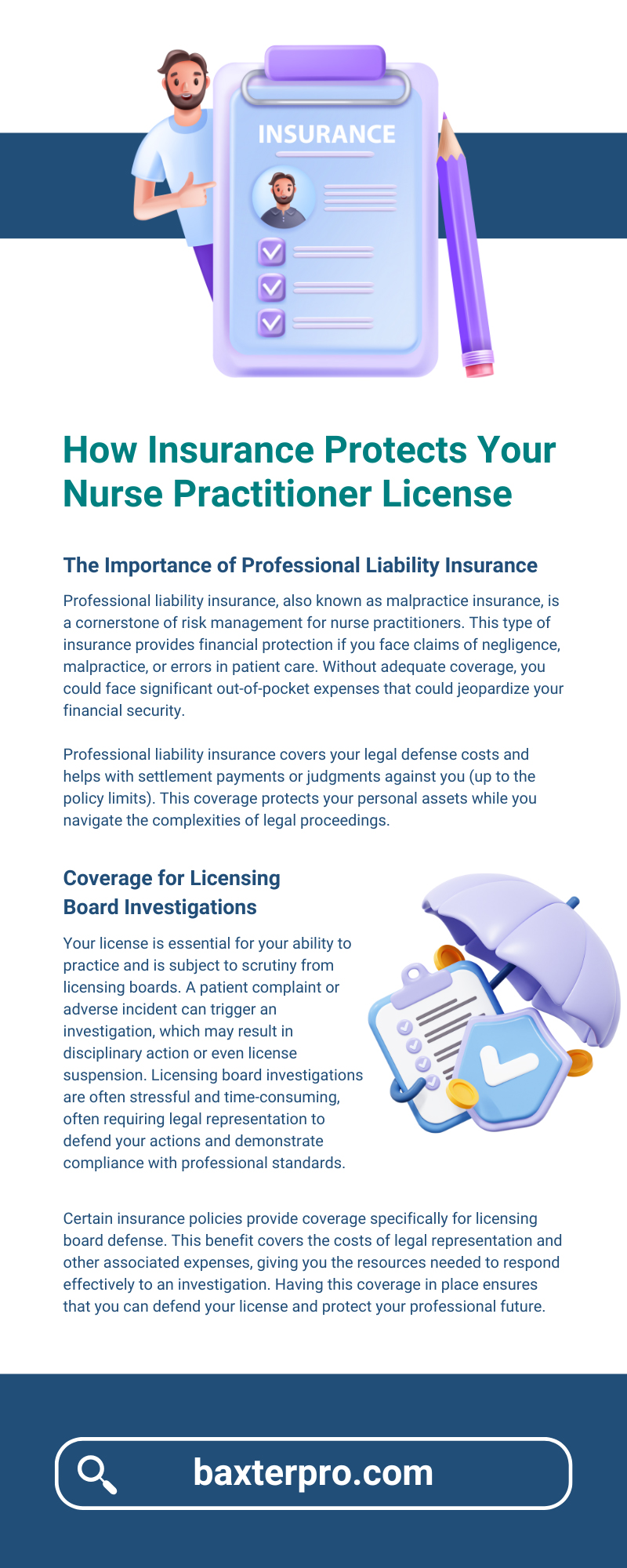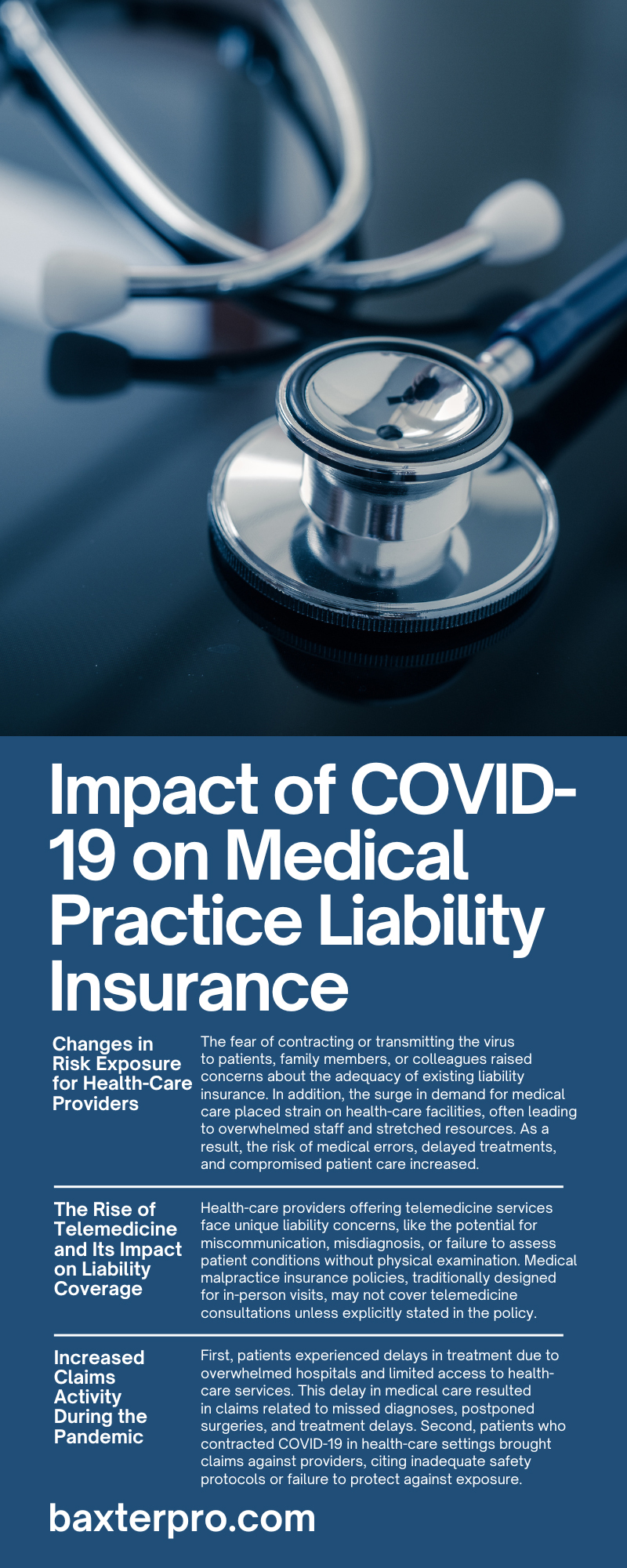Health-care professionals face numerous risks in their day-to-day practices. Protecting yourself from legal claims and lawsuits is essential to protect your career and financial stability.
Different types of health-care malpractice insurance policies cater to various needs and circumstances. Understanding these policies is crucial for selecting the right coverage for your practice.
1. Claims-Made Policies
Claims-made policies are incredibly popular in the medical profession. These policies provide coverage only if a claimant files a claim during the active policy period. Both the alleged incident and the reporting of the claim must occur while the policy is active.
One key feature of claims-made policies is their reliance on a retroactive date. Any incident occurring before this date will not be covered. Upon terminating a claims-made policy, you should consider purchasing tail coverage to protect against claims filed after the policy ends. Tail coverage is often expensive, so it’s vital to factor this cost into your decision-making process.
Claims-made policies often appeal to health-care professionals seeking flexibility and lower initial premiums. However, they require careful management to ensure uninterrupted coverage. Working closely with your insurance provider will help you understand the policy’s specific terms and conditions.
2. Occurrence-Based Policies
Occurrence-based policies differ significantly from claims-made policies. These policies provide coverage for any incident that occurs during the policy period, regardless of when a claimant files a claim. For example, if you hold an occurrence-based policy, and an incident occurs during the active period, you’ll have coverage even if the claimant files a claim years after the policy has ended.
The primary advantage of occurrence-based policies is their long-term reliability. You don’t need to worry about purchasing additional tail coverage after the policy expires. This stability makes occurrence-based policies appealing to health-care professionals who prefer simplicity and comprehensive protection.
However, occurrence-based policies typically have higher premiums than claims-made policies. The upfront cost may deter some health-care providers, but the peace of mind and convenience they offer can outweigh the expense.
Consulting a medical malpractice insurance agency can help you determine whether this option aligns with your long-term needs. Baxter & Associates will help you find an insurance solution that meets your practice’s coverage requirements.
3. Individual vs. Group Policies
Health-care professionals can choose between individual and group malpractice insurance policies. Individual policies meet the specific needs of a single provider. These policies often provide more personalized coverage and allow for greater control over the terms and conditions.
Group policies cover multiple providers under a single plan and are suitable for organizations such as hospitals, clinics, or physician groups. Group policies are generally more cost-effective, as insurers offer discounts for collective coverage. However, they may offer less flexibility in terms of customization.
When deciding between individual and group policies, health-care professionals should consider their work environment, career goals, and risk exposure. Independent practitioners may benefit from the tailored protection of an individual policy, while providers working in a group setting may find group policies more practical and economical.
4. Tail Coverage
Tail coverage is a critical consideration for claims-made policyholders. This add-on extends coverage beyond the policy’s termination date, ensuring protection against claims filed after the policy expires. Tail coverage is helpful for health-care professionals transitioning between jobs, retiring, or experiencing other career changes.
The cost of tail coverage varies depending on the insurer, the duration of coverage, and the provider’s claims history. In some cases, employers may negotiate tail coverage as part of a compensation package. It’s essential to confirm these details before accepting a position.
Although tail coverage adds an extra financial burden, it serves as a valuable safeguard against unexpected claims. Health-care professionals should evaluate the potential risks and benefits to determine whether tail coverage is a necessary investment for their practice.
5. Shared vs. Separate Limits Policies
Another important distinction in health-care malpractice insurance policies is whether they have shared or separate limits. Shared limits policies allocate a single coverage limit among multiple insured parties, such as a physician and their practice. If a claim arises, the insurance company divides the policy’s maximum payout among all insured parties.
Separate limits policies provide individual coverage limits for each insured party. This arrangement ensures that one party’s claim doesn’t reduce the coverage available to others. Separate limits policies are often more expensive, but they offer enhanced protection and financial security.
Health-care professionals should carefully review their insurance contracts to understand the implications of shared and separate limits. Consulting with an experienced insurance advisor like Baxter & Associates can help you make an informed decision based on your specific risk exposure and coverage needs.
6. Specialized Policies for High-Risk Specialties
Certain health-care specialties face higher risks of malpractice claims, necessitating specialized insurance policies. Surgeons, anesthesiologists, and obstetricians often require more comprehensive coverage due to the inherent risks associated with their practice.
Specialized policies can address the unique challenges of high-risk specialties. These policies may include higher coverage limits, broader liability protections, and additional support services, such as risk management training and legal representation.
While specialized policies are often more expensive, they’re essential for protecting high-risk professionals from significant financial losses. Health-care providers should work with a medical malpractice insurance company experienced in their specialty to find the most suitable coverage options.
7. Employer-Provided vs. Self-Purchased Policies
Many health-care professionals rely on employer-provided malpractice insurance policies as part of their benefits package. While this arrangement is convenient, it’s important to understand the limitations of employer-provided coverage. For example, these policies may not cover incidents that occur outside of your workplace or when performing volunteer work.
Self-purchased policies offer greater control and customization. They allow health-care providers to select the coverage that best meets their needs and ensure comprehensive protection across various scenarios. However, self-purchased policies require an investment and additional administrative effort.
Health-care professionals should evaluate their employment contracts to determine whether employer-provided coverage is sufficient. If not, supplementing with a self-purchased policy may be necessary to achieve adequate protection.
Key Considerations When Choosing a Policy
Selecting the right health-care malpractice insurance policy requires careful consideration of several factors. These factors include the following:
- • area of expertise
- • work environment
- • risk exposure
- • insurance budget
- • insurer’s reputation
- • financial stability
It’s also important to review the policy’s terms and conditions, including coverage limits, exclusions, and deductibles. Understanding these details will help you avoid unexpected gaps in coverage. Working with a trusted medical malpractice insurer can simplify the process and ensure you make an informed decision.
Baxter & Associates: A Reputable Medical Malpractice Insurance Agency
Health-care malpractice insurance is an essential safeguard for medical professionals. Understanding the different types of health-care malpractice insurance policies empowers organizations to choose coverage that aligns with their unique needs.
Partnering with a reputable medical malpractice insurance agency like Baxter & Associates makes it easier to navigate the complexities of selecting and managing your policy. By securing comprehensive protection, you can focus on delivering exceptional patient care with confidence and peace of mind.
















